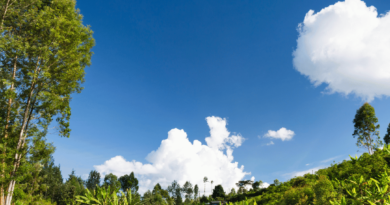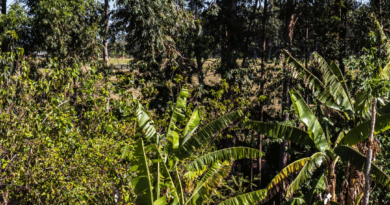Fruit Trees to Grow in an Urban Garden in Kenya
Kenya is known for its rich biodiversity, and many fruit trees can be grown in an urban garden. Here are five popular options to consider:
Mango (Mangifera indica) – Mangoes are a tropical fruit that thrives in Kenya’s warm climate. They require a lot of water and need to be protected from strong winds. They can be grown in pots or in the ground and can be propagated through grafting or air layering.
Mangoes are a popular fruit in Kenya and for good reason. Not only are they delicious, but they are also relatively easy to grow and can provide a valuable source of income for farmers.
- Choosing the Right Variety
The first step in growing a mango tree is to choose the right variety. There are many different types of mangoes, each with its own unique characteristics. Some popular varieties in Kenya include the Tommy Atkins, Kent, and Keitt. It’s important to select a variety that is well-suited to the local climate and soil conditions.
- Preparing the Site
Once you have selected a variety, the next step is to prepare the site for planting. Mangoes prefer well-drained soil with a pH between 6 and 7. The site should be cleared of any debris and weeds, and the soil should be loosened to a depth of at least 30 cm.
- Planting the Tree
The best time to plant mango trees in Kenya is during the rainy season, usually between March and May. When planting, the tree should be set in the hole at the same depth as it was in the container or balled and burlapped. The tree should be staked to keep it upright until it becomes established.
- Watering and Fertilizing
Mango trees require regular watering, especially during the dry season. In the first year, they should be watered at least once a week. As the tree matures, it can be watered less frequently. Fertilizing with a balanced fertilizer is also important, particularly during the tree’s first year of growth.
- Pruning and Training
Pruning and training are important to the development of a healthy and productive mango tree. Pruning should be done when the tree is young to encourage branching and a strong structure. As the tree matures, it should be trained to have a central leader and well-spaced branches.
- Pest and Disease Control
Mango trees are susceptible to a variety of pests and diseases. Regular monitoring and treatment with appropriate pesticides and fungicides can help to prevent these issues.
Avocado (Persea americana) – Avocados are another tropical fruit that can be grown in Kenya. They require well-drained soil and need to be protected from frost. They can be propagated through grafting or by planting seedlings.
Avocados are a popular fruit in Kenya, known for their rich, creamy texture and delicious taste. They are also a valuable crop, with a high market demand both locally and internationally. Growing avocado trees in Kenya can be a profitable endeavour for farmers and home gardeners alike.
- Climate: Avocado trees require a warm, tropical climate with temperatures that do not fall below 10°C (50°F). In Kenya, avocado trees can be grown in areas with an altitude of less than 1,500 meters above sea level, such as the coastal regions and the lower parts of the central highlands.
- Soil: Avocado trees prefer well-drained, sandy loam soils with a pH of 6.0 to 6.5. The soil should be rich in organic matter and have good water-holding capacity. Before planting, it is important to test the soil and amend it as necessary to ensure optimal growth.
- Care:
- Irrigation: Avocado trees require consistent moisture, especially during the dry season. Drip irrigation is the most efficient method of watering avocado trees.
- Fertilization: Avocado trees require regular fertilization to support healthy growth and fruiting. Organic fertilizers such as compost and animal manure can be used, along with mineral fertilizers such as nitrogen, phosphorous, and potassium.
- Pruning: Pruning is essential for maintaining the shape and size of the avocado tree and promoting fruit production. Prune the tree in the dormant season, removing any dead, diseased or crossing branches.
- Pest and disease management: Common avocado pests and diseases in Kenya include avocado thrips, avocado mites, avocado sunblotch viroid, and Phytophthora root rot. Regular monitoring and appropriate control measures should be implemented to prevent damage to the tree and fruit.
- Harvesting: Avocado trees take between 3 to 5 years to bear fruit, and can produce fruit for up to 20 years. The fruit is ready to harvest when it has reached full size, and the skin has turned from green to green-yellow.
Passion fruit (Passiflora edulis) – Passion fruit is a fast-growing vine that produces sweet and tangy fruit. It can be grown in pots or in the ground and requires a trellis for support. It can be propagated through cuttings or layering.
Passion fruit is a tropical fruit that is grown in many parts of the world, including Kenya. The fruit is known for its sweet and tangy flavour, and it is often used in juices, jams, and jellies. Passion fruit is also a good source of vitamins and minerals, making it a healthy addition to any diet. In this chapter, we will discuss how to grow passion fruit in Kenya, including information on soil preparation, planting, care, and harvesting.
- Soil Preparation
Passion fruit grows best in well-drained soils that are rich in organic matter. The soil should have a pH between 6.0 and 7.0. Before planting, the soil should be prepared by adding organic matter, such as well-rotted manure or compost. The area should also be cleared of any weeds or debris.
- Planting
Passion fruit is usually propagated by using cuttings or by planting seedlings. Cuttings should be taken from healthy and mature plants, and they should be about 10-15 cm long. The cuttings should be planted in a propagating bed and kept moist until they have rooted. Seedlings should be planted at the same depth as they were growing in the seedling tray.
- Care
Passion fruit plants require regular watering, especially during the dry season. They should be fertilized every 6-8 weeks with a balanced fertilizer. The plants also need to be protected from pests and diseases. Common pests include aphids, thrips, and whiteflies. Common diseases include powdery mildew and black spot.
- Harvesting
Passion fruit is usually ready to harvest after about 6-8 months. The fruit should be picked when it is fully ripe, which is indicated by the fruit turning from green to yellow. The fruit should be picked by hand and should be handled carefully to avoid bruising.
Guava (Psidium guajava) – Guava is a small tree that produces sweet and fragrant fruit. It can be grown in pots or in the ground and requires well-drained soil. It can be propagated through cuttings or air layering.
Guava trees are a popular fruit tree in Kenya, known for their delicious fruit and easy maintenance. Guavas are tropical fruit that can be grown in a variety of climates and soil types. In this chapter, we will discuss the best practices for growing guava trees in Kenya.
Before planting your guava tree, it is important to choose the right location. Guava trees thrive in well-drained soil and full sunlight. They can also tolerate partial shade but will produce less fruit. The ideal pH range for guava trees is between 5.5 and 7.5.
When planting your guava tree, make sure to dig a hole that is at least twice the size of the root ball. Mix in some compost or well-rotted manure to add nutrients to the soil. After planting, water the tree well and mulch around the base to help retain moisture.
Guava trees require regular watering and fertilization. Water the tree once a week, or more frequently in hot weather. Use a balanced fertilizer, such as 10-10-10, every three months. Pruning should be done to remove dead or diseased branches and to shape the tree.
Guava trees will begin to bear fruit in 3-4 years. The fruit is ready to harvest when it turns yellow and becomes slightly soft to the touch. Guava fruit can be eaten fresh or made into juice or jams.
In Kenya, guava trees are susceptible to pests and diseases such as fruit flies, scales, and powdery mildew. To prevent infestations, regularly inspect the tree and use organic pesticides or control methods if necessary.
Papaya (Carica papaya) – Papaya is a fast-growing tree that produces sweet and juicy fruit. It can be grown in pots or in the ground and requires a lot of water. It can be propagated through seedlings.
Pawpaw, also known as papaya or papaw, is a tropical fruit tree that is native to Mexico and Central America. It is a popular crop in Kenya, known for its sweet, juicy fruit and its high nutritional value. Pawpaw trees can be grown in a variety of soil types and climates, making them a versatile crop for Kenyan farmers. In this chapter, we will discuss the best practices for growing pawpaw trees in Kenya.
1.1 Selecting a Site
When selecting a site for your pawpaw trees, it is important to choose an area that receives at least six hours of direct sunlight per day. The trees also prefer well-draining soil that is high in organic matter. If your soil is poor, you can amend it with compost or well-rotted manure to improve its fertility.
1.2 Propagation
Pawpaw trees can be propagated by seed or by rooting stem cuttings. When starting from seed, it is important to use fresh, viable seeds and to keep them in a warm, humid environment until they germinate. Rooting stem cuttings is a faster method of propagation, but it can be more challenging to get the cuttings to root.
1.3 Care and Maintenance
Once your pawpaw trees are established, they will require regular care and maintenance to ensure that they continue to produce healthy fruit. This includes proper irrigation, fertilization, and pest and disease control.
1.4 Irrigation
Pawpaw trees require regular watering, especially during the dry seasons. It is important to keep the soil consistently moist, but not waterlogged. A drip irrigation system is a good option to ensure that your trees receive the right amount of water without wasting it.
1.5 Fertilization
Pawpaw trees require regular fertilization to ensure optimal growth and fruit production. Use a balanced fertilizer such as 10-10-10 or 14-14-14 and apply it at least twice a year.
1.6 Pest and Disease Control
Pawpaw trees can be susceptible to pests such as fruit flies and diseases such as leaf spot and powdery mildew. Regular monitoring and appropriate treatment are necessary to keep these issues under control.
1.7 Harvesting
Pawpaw fruit typically takes around three months to mature and will change color from green to yellow when it is ripe. The fruit should be picked when it is fully ripe, as unripe fruit will not ripen properly.
In conclusion, growing pawpaw trees in Kenya is relatively easy, and with proper care, the trees can produce high-quality fruit for years to come.
Citrus Fruit Trees –
Citrus fruit trees, such as oranges, lemons, and limes, can be successfully grown in an urban garden in Kenya. However, there are certain conditions and techniques that must be met in order for the trees to thrive. This chapter will provide an overview of the steps involved in growing citrus fruit trees in Kenya, including information on climate, soil, and care requirements.
- Climate
Citrus fruit trees require a warm and sunny climate in order to grow and produce fruit. Kenya, with its equatorial location, provides the ideal conditions for citrus tree growth. The average temperature in Kenya is around 27 degrees Celsius, and the country receives ample sunshine throughout the year. However, it’s important to keep in mind that citrus trees are sensitive to frost, so they should be planted in areas that do not experience frost or freezing temperatures.
- Soil
Citrus trees prefer well-drained soil that is rich in organic matter. The ideal pH range for citrus trees is between 6 and 7.5. If the soil in your area is too alkaline or acidic, it can be amended with the addition of lime or sulfur, respectively.
- Care
Once your citrus trees are planted, they will require regular care in order to thrive. This includes watering, fertilization, pruning, and pest control.
Watering: Citrus trees require a consistent supply of water, especially during the fruiting period. Trees should be watered deeply and regularly, so that the soil remains moist but not waterlogged.
Fertilization: Citrus trees require regular fertilization in order to produce healthy fruit. A balanced fertilizer that contains nitrogen, phosphorous, and potassium should be applied every 3 to 4 months. Organic matter like well-composted cow dung and chicken manure can also be used for organic farming.
Pruning: Pruning is important for maintaining the shape and size of citrus trees, as well as for promoting fruit production. Trees should be pruned annually, removing any dead or diseased branches and shaping the tree to allow for good air circulation.
Pest Control: Pests and diseases can be a problem for citrus trees in Kenya. Common pests include citrus leaf miner, citrus mealybug, and citrus thrips. These pests can be controlled through the use of pesticides and other control methods like biological control, crop rotation, and companion planting.
References:
- “Mango cultivation” by KARI, accessed January 21, 2023, https://www.kari.org/mango-cultivation/
- “Growing Avocados in Kenya” by KEPHIS, accessed January 21, 2023, https://www.kephis.org/growing-avocados-in-kenya/
- “Passion Fruit Production” by Ministry of Agriculture, Livestock and Fisheries, accessed January 21, 2023, https://www.agriculture.go.ke/passion-fruit-production/
- “Guava Cultivation” by KEPHIS, accessed January 21, 2023, https://www.kephis.org/guava-cultivation/
- “Papaya Production” by Ministry of Agriculture, Livestock and Fisheries, accessed January 21, 2023, https://www.agriculture.go.ke/papaya-production/
- “Mango – Production Guide” by the Kenya Agriculture and Livestock Research Organization (KALRO)
- “Growing Mangoes in Kenya” by the Ministry of Agriculture, Livestock, and Fisheries
- “Pests and Diseases of Mango” by the Kenya Plant Health Inspectorate Service
- Gichuki, F.N., and M.J. Ngugi. “Passion fruit production in Kenya.” African Crop Science Journal, vol. 3, no. 3, 1995, pp. 323-329.
- Thottappilly, G., and R.K. Shetty. “Postharvest physiology of passion fruit (Passiflora edulis Sims).” Journal of Horticultural Science, vol. 74, no. 3, 1999, pp. 300-307.
- Wanyoike, M. “Passion fruit production and marketing in Kenya.” Journal of Agriculture and Rural Development in the Tropics and Subtropics, vol. 107, no. 2, 2006, pp. 143-150.
- “Guava Production Guide” by Kenya Agricultural and Livestock Research Organization (KALRO)
- “Growing Guavas in the Home Garden” by University of Hawaii at Manoa College of Tropical Agriculture and Human Resources
- “Guava: Postharvest Handling and Processing” by Food and Agriculture Organization of the United Nations (FAO)
- “Citrus Fruit Production in Kenya” by K.G. Karugia and D.K. Mbugua. Journal of Agriculture and Ecology Research International, Vol. 2, No. 4, 2013.
- “Citrus Cultivation in Kenya” by the Kenya Ministry of Agriculture.
- “Citrus Pest Management in Kenya” by D.M. Mulei and J.K. Mungai. Journal of Agriculture and Ecology Research International, Vol. 3, No. 3, 2014.
- “Growing Citrus Fruit Trees: A Beginner’s Guide” by T.J. Calloway. Gardening Tips and Tricks, 2016.
- “Growing papaya in Kenya” by George Kamau, (https://www.agriculture.co.ke/farming/papaya-farming-kenya/)
- “Papaya Cultivation in Kenya” by Kenya Agriculture and Livestock Research Organization (KALRO) (https://www.kalro.org/index.php/services/horticulture-crops-research-programme/item/papaya-cultivation-in-kenya)
- “The Papaya Industry in Kenya” by The Kenya Horticultural Council (https://www.horticulturekenya.org/the-papaya-industry-in-kenya)




